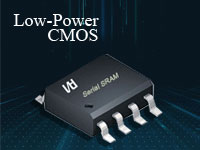Micron DRAM access 1 β times
Micron is shipping DRAM memory chip samples with the highest bit density so far. Compared with the previous generation, the power efficiency of the 16 Gb DRAM chip is increased by 15% and the density is increased by 35%. Micron realized this improvement without the help of the most advanced chip manufacturing technology - extreme ultraviolet lithography technology. The features that make up DRAM cells are not as small as those on logic chips, but progress shows that the density of DRAM may still be further reduced in the future.
The sample of LPDDR5X chip is being delivered, which is the memory manufactured for power limited systems such as smart phones. (Unpacking LPDDR5X means that the low-power version of the 5th generation double data rate memory communication standard has been improved, and it can transmit 8.5 Gb per second.) It is the first chip manufactured using the new manufacturing process of Micron, called 1-beta. The company said that it maintained its leading edge over competitors such as Samsung and SK Hynix a year ago.
The manufacturing process of DRAM and logic chip diverged several decades ago. As time passed, logic chip actively reduced transistors. The reason for the divergence is related to the structure of DRAM. DRAM stores a little charge in the capacitor. Access to each capacitor is gated by transistors. But the transistor is an imperfect barrier, and the charge will eventually leak out. Therefore, DRAMs must be refreshed periodically to restore their bits before they are exhausted. In order to improve the memory density while maintaining a reasonable refresh cycle, DRAM manufacturers have to make some quite radical changes to the composition of capacitors. For Micron and other major manufacturers, it is now like a tall pillar, and is made of materials not found in logic chips.
Memory manufacturers have been investing in the latest key manufacturing tool owned by logic chip companies: extreme ultraviolet lithography. However, Micron uses a proprietary version of the "multi pattern" technology, while adhering to the 193 nanometer immersion lithography technology that has been used for a long time. Multiple patterns include projecting patterns, etching, and cycling of deposited materials, then projecting another pattern - done in such a way that interactions produce a finer structure than any single pattern.
No need to use EUV is the "real trick". But it follows a trend. For more than ten years, Micron has been able to use the old technology and equipment more intelligently than others.
CONTACT US
USA
Vilsion Technology Inc.
36S 18th AVE Suite A,Brington,Colorado 80601,
United States
E-mail:sales@vilsion.com
Europe
Memeler Strasse 30 Haan,D 42781Germany
E-mail:sales@vilsion.com
Middle Eastern
Zarchin 10St.Raanana,43662 Israel
Zarchin 10St.Raanana,43662 Israel
E-mail:peter@vilsion.com
African
65 Oude Kaap, Estates Cnr, Elm & Poplar Streets
Dowerglen,1609 South Africa
E-mail:amy@vilsion.com
Asian
583 Orchard Road, #19-01 Forum,Singapore,
238884 Singapore
238884 Singapore
E-mail:steven@vilsion.com
